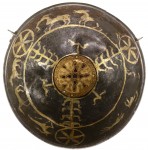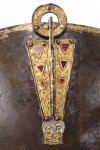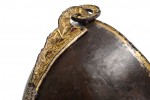 Leiden University archaeologists have unearthed a rare and beautiful silver bowl from the from the early 7th century in Oegstgeest, a town in the province of South Holland in the western Netherlands. It was discovered just over a year ago, on June 4th, 2013, during the excavation of village from the 6th and 7th century on the banks of the Rhine. The find wasn’t announced for a year to allow the team to complete the excavation without interference from treasure hunters and lookie-loos.
Leiden University archaeologists have unearthed a rare and beautiful silver bowl from the from the early 7th century in Oegstgeest, a town in the province of South Holland in the western Netherlands. It was discovered just over a year ago, on June 4th, 2013, during the excavation of village from the 6th and 7th century on the banks of the Rhine. The find wasn’t announced for a year to allow the team to complete the excavation without interference from treasure hunters and lookie-loos.
 The silver bowl itself dates to late antiquity, probably around 300-500 A.D., and is decorated with plant and animal figures in gold leaf. On the inside, three large trees or plants go from the base of the bowl to a border frieze. The plants divide the frieze into three sections separated by rosettes. Each section features animal figures running, one set appears to be three deer, another is two bucks and a dog, the third is two mythological animals, one of which appears to be carrying a human leg in its mouth. These decorative motifs suggest the bowl was originally manufactured in the eastern Mediterranean or Middle East.
The silver bowl itself dates to late antiquity, probably around 300-500 A.D., and is decorated with plant and animal figures in gold leaf. On the inside, three large trees or plants go from the base of the bowl to a border frieze. The plants divide the frieze into three sections separated by rosettes. Each section features animal figures running, one set appears to be three deer, another is two bucks and a dog, the third is two mythological animals, one of which appears to be carrying a human leg in its mouth. These decorative motifs suggest the bowl was originally manufactured in the eastern Mediterranean or Middle East.
 It’s the elaborate gold and garnet appliqués that date to the first half of the 7th century. The base of the bowl is inset with a central disc that has garnets inlaid in a cross pattern. Between the garnets are swirls made of knotted gold wire. Tiny versions of the swirls decorate the border of the disc. There are two mounts with suspension rings added to the outside of the bowl. They too are gold with garnet accents and swirls of knotted gold wire. The style of decoration is from the German Rhineland (except for the suspension rings which are more in keeping with English and Scandinavian styles), so someone took an expensive Eastern bowl and made it even more expensive by adding Germanic gold accents.
It’s the elaborate gold and garnet appliqués that date to the first half of the 7th century. The base of the bowl is inset with a central disc that has garnets inlaid in a cross pattern. Between the garnets are swirls made of knotted gold wire. Tiny versions of the swirls decorate the border of the disc. There are two mounts with suspension rings added to the outside of the bowl. They too are gold with garnet accents and swirls of knotted gold wire. The style of decoration is from the German Rhineland (except for the suspension rings which are more in keeping with English and Scandinavian styles), so someone took an expensive Eastern bowl and made it even more expensive by adding Germanic gold accents.
 The rings are characteristic of hanging bowls and the handsome interior decoration would certainly be more effectively shown off if the bowl were suspended with the interior visible. However, in order to hang evenly the bowl would have needed a third ring and there’s no evidence of a third mount on the bowl, not even rivet holes. It’s possible the piece was in the process of being manufactured, which would make it a very rare artifact captured mid-production.
The rings are characteristic of hanging bowls and the handsome interior decoration would certainly be more effectively shown off if the bowl were suspended with the interior visible. However, in order to hang evenly the bowl would have needed a third ring and there’s no evidence of a third mount on the bowl, not even rivet holes. It’s possible the piece was in the process of being manufactured, which would make it a very rare artifact captured mid-production.
The bowl was presumably used as a drinking vessel or a wash basin initially, but at some point a small hole was made in the base of the bowl from the outside in. The hole would have made it impossible for the bowl to hold liquids without leaking and it seems to have been done on purpose.

The ancient village was criss-crossed by several small waterways leading to and from the Rhine. The bowl was found in one of those small waterways, and archaeologists believe it was deliberately deposited as a sacrifice.
Researchers are assuming that the bowl, which is 21 centimetres wide and 11 centimetres high, was buried as part of a ritual sacrifice. Such gilded discoveries are extremely rare. This one is exceptional because such bowls were usually made of bronze. In addition, they were not, as a rule, lavishly decorated with gold leaf. This means that we are dealing with an artefact that is unique, not only for the Netherlands, but for all of Western Europe. (Until the discovery of this bowl there were no indications of the presence of a local or regional elite on the Oegstgeest settlement. It may be that in this period some members of the elite lived on ‘simple’ farms.)
 The was in pieces when it was first found. A full restoration funded by the Province of South Holland has returned it to its former glory. The bowl is now on display at the Dutch National Museum of Antiquities as part of the Golden Middle Ages exhibition that runs through October 26th. After that, it will be exhibited in the museum’s permanent collection on long-term loan from the Province of South Holland.
The was in pieces when it was first found. A full restoration funded by the Province of South Holland has returned it to its former glory. The bowl is now on display at the Dutch National Museum of Antiquities as part of the Golden Middle Ages exhibition that runs through October 26th. After that, it will be exhibited in the museum’s permanent collection on long-term loan from the Province of South Holland.
Second paragraph, end of third line: “gold” leaf, perhaps?
Oh no, I definitely meant golf leaf. :giggle: :thanks:
The hole in the bottom would have been used to mount the thing on the wall, would be my guess.
That’s possible. The archaeologists tend to think it was done deliberately to make it impossible to drink from the vessel, however, perhaps as part of the sacrifice ritual.
Maybe part of an early water clock? It only has 2 mounts because the other side rested on a larger bowl that caught the water dripping out of the tiny hole in the bottom to mark a unit of time? (The hole is on the side without a hanging ring.)Just random thinking…
What a cool idea. I think it’s probably a little more complicated a solution than the archaeologists are leaning towards, but I love it. :yes:
The Holy Grail, at last ! – Well, that bowl is definitely an interesting one. What about further contexts of this find ? What is all that riverbank wood about ? To my unskilled eye, these gold inlays look ‘nordic’, whereas the bowl itself, the gold and the garnets might be ‘byzantine’. Garnet -in this case from India- was not unheard of in what is now the Netherlands, cf.: http://penelope.uchicago.edu/hydrionoframes/bees.html
The garnet inlays in that ‘cross pattern’ might be a christian reference, but they could also be some form of ‘scale’. Were exactly is the hole ? In my wildest phantasies -if I leave aside the really wild ones- this could have been used as some form of very early wet compass: Once the water had gone, you would have known your way. My alternative hypothesis, of course, would be that they could have stored apples in there.
Suddenly my fruit bowl looks very, very boring. 🙁
The placement of the two rings is curious indeed. Maybe it was hung from a beam, allowing a viewer to see both the interior and exterior.